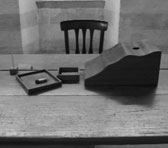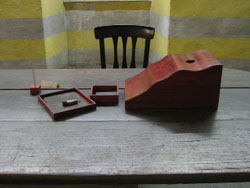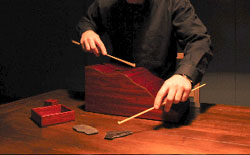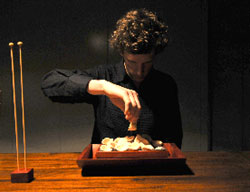27 November 2008
Rosemary Joy and the sound world in miniature
 Image: Rosemary Joy's miniature instruments have been picked up by percussionists all over the world
Image: Rosemary Joy's miniature instruments have been picked up by percussionists all over the world Ensemble Offspring will premiere two new Australian works in their forthcoming concert on 10 December: Michael Smetanin's new piece and Rosemary Joy's Beauty Boxes - a structured improvisation for two percussionists. In this interview, Joy talks about her exquisite, wooden miniature instruments, about the people who play them and the people who get involved by observing and listening.

audience sitting so close that kind of strips bare
the performer. There is no anonymity or hiding
behind a huge drama, it's just completely exposed.'
Rosemary Joy's art revolves around exquisite sculptures - percussive instruments on a miniature scale. In her current project, Beauty Boxes for Ensemble Offspring's percussionists Claire Edwardes and Bree van Reyk, Joy's precious, handmade instruments take the familiar form of a beautifully crafted, wooden box, opening up a whole, new world of sound to both performers and the audience. How did someone with a training in visual arts end up fascinated about sound, collaborating with leading percussionists and voluntarily restricting her audiences to just a handful of people at any one time? It turns out Joy had some formative musical experiences that lacked subtlety and had to do with big and loud audiences.
'I have a visual arts background, but I also spent a number of years playing in a rock band, an all-girl band. It was fun at the time, but I became increasingly frustrated with the idea of just cranking out these songs over and over again. What I am doing now is almost like a reaction to that experience of performing very loud music to a mass of drunken people - one extreme in my past - compared to now creating subtle sounds for a very small number of people. There's a kind of preciousness to the experience that the audience has with the miniature percussion - everything is handmade and unique as opposed to mass-produced.'
Many of the projects Joy has been involved with have been collaborations involving herself and the composer David Young, under the umbrella of the Melbourne-based Aphids organisation. Her first projects with Aphids had to do with creating sculptural scores - the next step was a collaboration with percussionist Vanessa Tomlinson, sculptures that were not just scores but also instruments.
'Initially they were all devised with a particular percussionist in mind: they were custom-built for a specific person, to create sounds that would delight that person. It was almost an idea that the instrument would be only played by that person, in that particular event, and once the event had happened, it wouldn't happen any more', Joy explains.
Beauty Boxes grew out of a recent miniature percussion project called Underground that she and David Young created in 2007. The Dutch percussion ensemble Slagwerkgroep Den Haag performed the work. The Australian percussionist Claire Edwardes was one of the performers and started to talk to Rosemary Joy about a new project. The idea started to take form while Joy was watching the performances in The Hague.
'A new work can start with an initial conversation with the percussionist about their favourite sounds, or I work from the architecture of the space that the work will be performed in. Then I'll go off and create the instrument and later take it back to the musician and composer. Each project is different, though, and I'm interested in working in different ways. To begin with, I was quite rigid, I only wanted to work in the same way, starting with the musician's favourite sounds, and the work would only be performed once. It has become more and more flexible.'

© Heidrun Löhr
This has meant that a work like Underground has been picked up by different people in different countries. It has already been performed by musicians in the Netherlands, in Mexico, in Italy and in Japan. The size of the audience for Underground varied, too - in Belgium there was an audience of four at a time. The performances in Japan an unusually large audience for Joy - all 20 of them.
'One of the smallest audiences would have been for the Schallmachine 06 project with an audience of three and a solo percussionist. That was a collaboration between the Swiss percussionist Fritz Hauser, architect Boa Baumann, Aphids and Speak Percussion that took place underneath Federation Square during the Melbourne Festival 2006. Schallmaschine 07:klein was a further development of the work in Basel in 2007. I've had the enormous privilege to see my instruments being performed by many, many different percussionists.'
Rosemary Joy is usually not particularly involved with the rehearsal process. She sits and observes and might take on the practical role of an usher during the performance. Her interest lies in the meeting of the percussionist and the audience, through the wooden sound sculpture.
'There is something about the intimacy of the audience sitting so close that kind of strips bare the performer. There is no anonymity or hiding behind a huge drum, they are just completely exposed. Most of the people I've worked with have found it really refreshing. I think there's been one or two that have been a little bit confronted and a bit daunted by it. And often, after the performance, the audience will stay and talk and have this real engagement with the musicians. There's no waiting until you get out into the foyer.'

© Heidrun Löhr
'And just as it can be a challenge for the musician to have the proximity, it also demands more from the audience. They can't not be attentive to what is happening because they are so close. The musicians can tell if they are drifting off or looking at their program, they can't do all that. '
Rosemary Joy started off by working with fabrics (she devised a musical ball gown instrument for the percussionist Vanessa Tomlinson), but soon her attention turned to wooden miniature instruments. They have proved to be the perfect way of exploring the link between sculpture and music.
'For many years, I've been interested in that link. To work with Aphids has created an incredible forum in which to explore a range of ideas within the context of cross-artform collaborations. It has been really inspiring to work with composer David Young on many occasions. I have always been fascinated by percussion, the incredible flexibility of it - that anything can be played. I find percussionists have that openness to leap into the unknown. I think a lot of percussionists also like the idea of playing these very small objects, rather than lugging massive gear around and then spending three hours trying to set it up, and then pack up again in the end. That's been a thing they really enjoy, just having a very small box with everything in it. And that's the show.'
Beauty Boxes will give the two percussionists relatively free hands to improvise, based on instructions provided by Joy.
'I had quite a clear idea in my mind of how I wanted the boxes to be approached, so I'm developing a list of instructions for the musicians - it will be a structured improvisation. I always make the instruments with a clear idea of the possibilities there. Many times I've been surprised and delighted by what the musicians and David have discovered. In this case, I was interested to make the instrument with a sense of the score in my mind, rather than making them and handing them over.'
'These boxes are relatively simple compared to some others that have been quite complex. It's basically two, identical boxes with three drawers in each, a little bit reminiscent of a jewellery box, or a box of precious objects. The boxes themselves can be played - I've used African rosewood that's very resonant and has a beautiful sound quality - and there are also found objects inside the drawers that can be played.'
There are some obvious challenges in organising a concert with both big pieces for normal audiences and intimate pieces for a strictly limited audience. Beauty Boxes will form a part of a concert program, but only the first 50 audience members - in groups of ten - will get to experience it.
'It will be basically set up like a dinner party, with two musicians on one side and the audience on the other side. It will be staged in the dressing rooms at the back of the Performance Space at Carriageworks, so that the audience will have a little journey in order to get into this place. It's interesting to see the way that the audience's journey leading into the space actually prepares them and opens their ears to what they are about to hear. I find that quite intriguing: sometimes they have gone and heard one of these pieces, and then when they come out, they are much more tuned to the ambient sounds around them. They can hear the coffee cup hitting the saucer and the key going into the lock, and these sorts of sounds which mostly we are not really sensitised to.'
Joy's instruments are beautiful objects as such and have sometimes been exhibited as conventional sculptures.
'That was okay, but it is the sound that I am really interested in. I'm interested in the way that the sculpture, and being close to it and looking inside it, affects people's experience of the sound.'
The space in which the performance happens is also important, and some of her works are very site-specific.
'Some of the instruments have been inspired by the architecture of the venue in which the performances were held. Next year I'll be working on a big project with Aphids, called System Building. It's basically a tour to a number of different venues, and the work itself will be a version of the tour in miniature, the musicians will move from instrument to instrument, and each instrument is inspired by one of the buildings in which it is being played. The architecture of the building will be mirrored in the instrument in some way.'
'I'm also creating a work with a Mexican percussionist, Evaristo Aguilar, that is inspired by the Day of the Dead celebrations. Last year I spent some time going to very tiny villages in a remote part of Mexico to observe the celebrations and witness different rituals for the Day of the Dead festivities - an extraordinary experience. I will make a series of instruments and Evaristo will compose and perform this work, called Xantolo, first in the Melbourne Recital Centre next year and then in Mexico. And there is also another Aphids project Yakumo Honjin which is a collaboration between myself, David Young, film artist Peter Humble and four musicians - it's inspired by a 280-year-old samurai hotel in Far West Japan - an incredibly beautiful, tranquil space, tiny little rooms, lots of corridors, tatami mats and shoji screens. That work will also go back to Japan.'
Could working in tranquil spaces, producing mostly quiet and subtle sounds have the side effect of making a person intolerant of big sounds, big pieces, and noise?
'I must say my preference is for sounds that are more at the quieter end of the spectrum. I find I switch off a bit when I'm listening to music that is quite loud. I disengage somehow, I find that when I'm listening to more subtle sounds, my ears open out and I listen more carefully.'
Event details
Ensemble Offspring: To the Max
Artistic Director: Damien Ricketson
Assistant Artistic Director: Claire Edwardes
10 December 2008, 7 pm
Carriageworks, Wilson Street, Eveleigh, NSW
Tickets: $35/$20
Bookings: www.carriageworks.com.au or 1300 723 038
New works by Michael Smetanin and Rosemary Joy, also: Feldman,
Lachenmann, Andriessen.
Further links
Video excerpt of the first performance of Underground
(in the Netherlands, 2007) on YouTube (http://au.youtube.com/watch?v=r36B6u5AHhU)
Ensemble Offspring (www.ensembleoffspring.org.au/)
Aphids (www.aphids.net/)
Claire Edwardes (www.claireedwardes.com/)
Bree van Reyk - MySpace (www.myspace.com/breevanreyk)
Carriageworks (www.carriageworks.com.au/)
Article on Fritz Hauser and Schallmachine (Melbourne
Festival 2006) in RealTime (www.realtimearts.net/article/issue76/8270)
© Australian Music Centre (2008) — Permission must be obtained from the AMC if you wish to reproduce this article either online or in print.
Subjects discussed by this article:
- Rosemary Joy (Interviewee)
Anni Heino is a Finnish-born journalist and musicologist, and editor of resonate magazine.
Comments
Be the first to share add your thoughts and opinions in response to this article.
You must login to post a comment.